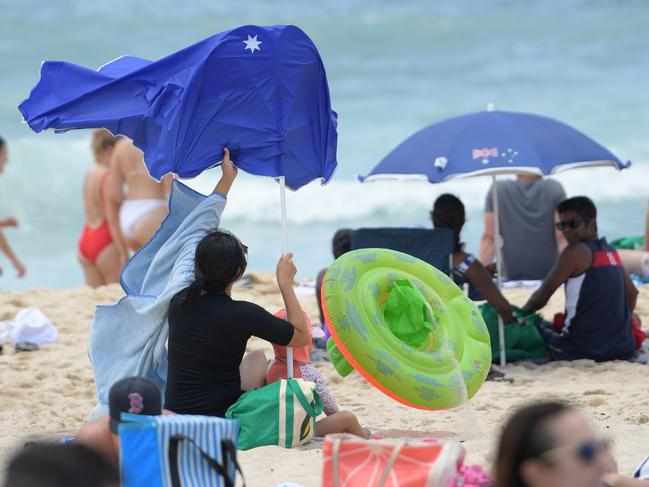Heatwave to scorch Sydney made worse in the west by winds
Traffic jams on the M4 make motorists hot under the collar, but there’s a scientific reason why the thermometer spikes west of the M7 intersection. The details have emerged after Sydney is set to bake in five days of above 40C temps.
NSW
Don't miss out on the headlines from NSW. Followed categories will be added to My News.
- Sydney to scorch in five days of 40C temperatures
- Incredible dust storm turns day into night
- The rodeo defying odds with big tourist boom
Sydney will be split into two cities again this week thanks to the weather event which divides the sprawling metropolis into the “haves” and “have nots” every summer.
The “sea breeze” is as Sydney as barbecues and zinc noses during the summer months. It, along with the geography of Greater Sydney, is the reason why Bondi can be 29C and Blacktown 40C on the same hot summer’s day.
Simply, the “have” suburbs along and near the coast get the cooling effects of winds — generally from the north-east and east — which flow in off the Pacific Ocean, hence the label sea breeze.
But these winds fade away and heat up as they flow across Sydney and the “have not” suburbs west of a line of higher ground running between Camden and Castle Hill swelter in hot and stale air.
This week, Sydney is about to swelter through five days of above 40C temperatures as a ‘severe’ heatwave strikes every state and territory in the country.
While a sea breeze will shield the city to some extent, Western Sydney has been warned to expect ‘extreme’ conditions over the next few days.
Residents in Penrith and Richmond will swelter through a week of above 40C temperatures with an expected peak of 43 degrees on Friday.

It’s what is also going to happen again this week as a high pressure system builds between Tasmania and New Zealand.
It will block cold air and cloud cover from crossing NSW and allow the type of weather which sees sea breezes, and those great disparities between temperatures in western and eastern Sydney. The same thing happened in late December and the first week of January.
This week should feature temperatures rising to 42C in western suburbs, but with coast up to eight degrees cooler.
MORE FROM JACK MORPHET:
ONE MONTH FOR KIDS TO FINISH HOMEWORK
PARENTS WANT MORE SPACES FOR AFTER-SCHOOL CARE
A study by the NSW Office of Environment and Heritage and Macquarie University found any real relief by sea breezes peters out about nine kilometres from the coast.
The study found a cool wind off the sea takes two hours to reach Blacktown and by then it’s diminished greatly and also been heated by the land.
Parramatta typically records 13 days hotter than 35C each year, while Sydney’s CBD only averages four.
The difference in summer temperatures between Penrith and the coast average about seven degrees but among the biggest differences recently recorded was in November 2014, when Sydney reached 30.1C while Penrith recorded 44.9C — a disparity of 14.8C.
On a local level, sea breezes happen as air over the land heats up and rises, and cooler air from the ocean rushes in to replace it. The cycle repeats as the cool air itself heats up and flows back over the ocean.
But on a much bigger scale, NSW’s heatwaves can be caused by a belt of high pressure called the “subtropical ridge” that sits over southern Australia during summer, bringing high pressure systems responsible for long spells of blue skies and searing heat. The high pressure systems spin counterclockwise and push north-east winds across NSW.
Sydney’s geography also doesn’t help western Sydney escape sweating in summer.


A ridge that divides the Sydney basin, running from Camden to the Hills district, traps hot westerly winds and also blocks out or deflects sea breezes.
“When you drive along the M4 from the city, you’re driving slightly uphill until the intersection of the M4 and M7 (at Eastern Creek) then it’s downhill until near the foot of the Blue Mountains,” Senior Research Fellow at Western Sydney University Dr Sebastian Pfautsch said. “It’s not many metres but there’s a lip that’s efficient enough to hold in the heat and there’s less air movement because of the depression.
“The deepest point in the depression is Penrith, where you get the hottest temperatures because the hot air sits in there nicely.”

Dr Pfautsch said the building boom in western Sydney is also creating more “heat islands” contributing to higher night temperatures as heat absorbed by concrete and brick during the day is released. Road traffic and airconditioning exhausts add to the problem.
“You’d think heat islands would be worse in the eastern suburbs, where there’s a higher density of infrastructure, but the eastern suburbs are cooled by the sea breeze,” he said.
But all’s not rosy for those lucky enough to be at the beach and enjoying nature’s “air conditioner” — the sea breeze.
Persistent north-easterly winds also bring the risk of frigid water, and bluebottles.
The water at Sydney’s beaches earlier this month was six degrees cooler than average because weeks of north-easterly winds blew the warm water away and cold water from the deep ocean rushed up to replace it.
Originally published as Heatwave to scorch Sydney made worse in the west by winds



